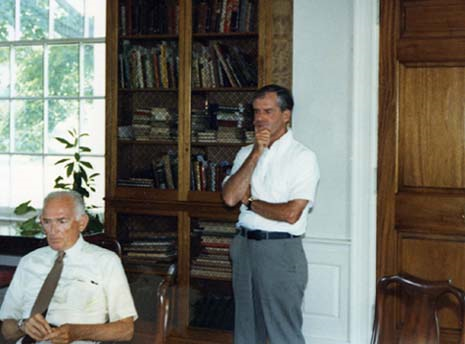 Dr. Fran Scheid (standing) passed away at 90 Dr. Fran Scheid (standing) passed away at 90
Handicap Formula Trailblazer Passes Away
Cliff Schrock, Golf Digest
Wednesday, March 2, 2011
Trailblazers, no matter what the field, lead the way to new frontiers because they use their energy, insight and passion in a way no one else dared try. Dr. Francis J. Scheid was such a golf innovator, and likely one you've never heard of. But if you're a high-handicapper you owe him a debt of gratitude because his research helped boost your handicap strokes to the level that gives you a fighting chance against the big boys.
In 1971, Scheid, a computer specialist who taught mathematics at Boston University, introduced a handicap study that led to a change in the USGA handicap formula in effect then. His work also led to the formation of the U.S. Golf Association Handicap Research Team in 1978, according to Dean Knuth.
Knuth, who became Director of Handicapping who developed the USGA Course Rating and Slope Rating system, was part of that team behind the final adoption in 1991 of the Slope System, which is used today to factor in a course's difficulty with handicap-stroke allotment. The "Pope of Slope" paid homage to his fellow handicap innovator, who passed away Feb. 24 at the age of 90. Scheid, Knuth said, "was a pioneer in the science of handicapping. He was a fine man."
Golf Digest was Scheid's first national forum to express his work. In June 1971, the magazine printed his research in the article, "You're Not Getting Enough Strokes!" A Golf Digest reader and 9-handicapper, Scheid had spent a year and a half studying the handicap system, feeling doubtful of its accuracy. For the study, he traced 500,000 two-ball matches (overall he had research on 2 million matches) and put in 400 man hours, aided by an IBM-360 computer.
One of his main conclusions in finding how to give the weaker golfer an equal chance to win was: For two golfers of differing handicap to play a match on a truly equal footing, the USGA handicap of the weaker golfer had to be supplemented by extra strokes. And the number of extra strokes needed increased as the difference in the weaker and stronger player increased. An example used in the article showed that in a match between 10- and 15-handicappers, the 15 should have gotten 1.3 strokes more than the 5 he was getting.
Scheid felt that his study showed the present USGA system had a heavy bias in favor of the low-handicap golfer. The story said "part of [the USGA] premise is that the higher a golfer's handicap, the better his chance of shooting a score lower than the average of his 10 best. In other words, he has more room for improvement." Scheid added, "The weaker golfer could be pardoned for wondering if it is really necessary to stack the odds quite so high against him. Many more strokes could be given, yet he would remain an underdog."
Scheid's solution was to increase the current handicaps by 27 percent. "The simplest way to do this would be to follow the current USGA method of finding the player's average differential -- using the 10 lowest differentials of his last 20 -- but then produce his handicap by multiplying this average by 108 percent, instead of the current 85." The USGA nearly heeded Scheid's findings in full, making a change from 85 percent to 96 percent in 1976.
Scheid continued his innovative handicap thinking with an October 1973 Golf Digest article, "Does Your Handicap Hold Up on Tougher Courses?" In that study on how a handicap is affected when a golfer travels to a much tougher course -- or weaker -- than his own, he fed 6,000 scorecard figures from 300 scratch to high-handicap golfers into a computer. He created the Scheid System, "a realistic formula for making handicaps more equitable for golfers playing courses other than their own."
Golf Digest followed the reaction to Scheid's work and in August 1975 ran a shortened version of his 1971 article and reported on how the USGA had adjusted its system. We last utilized his math skills in September 2005 when he calculated a litany of odds for making holes-in-one, such as 12,000 to 1 for the average golfer.
Scheid, who also loved sailing and birding, went by a golf moniker of his own -- Professor Golf -- and wrote three golf books, all with Jones River Press, primarily on observations about the game: "You Can't Get Lost on a Golf Course" in 1998; "Golfers Come in Many Shapes and Sizes" in 2002, and "Student of the Game" in 2004.
-- Cliff Schrock, Editor, Golf Digest Resource Center
|




